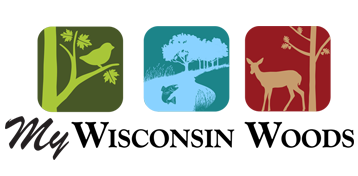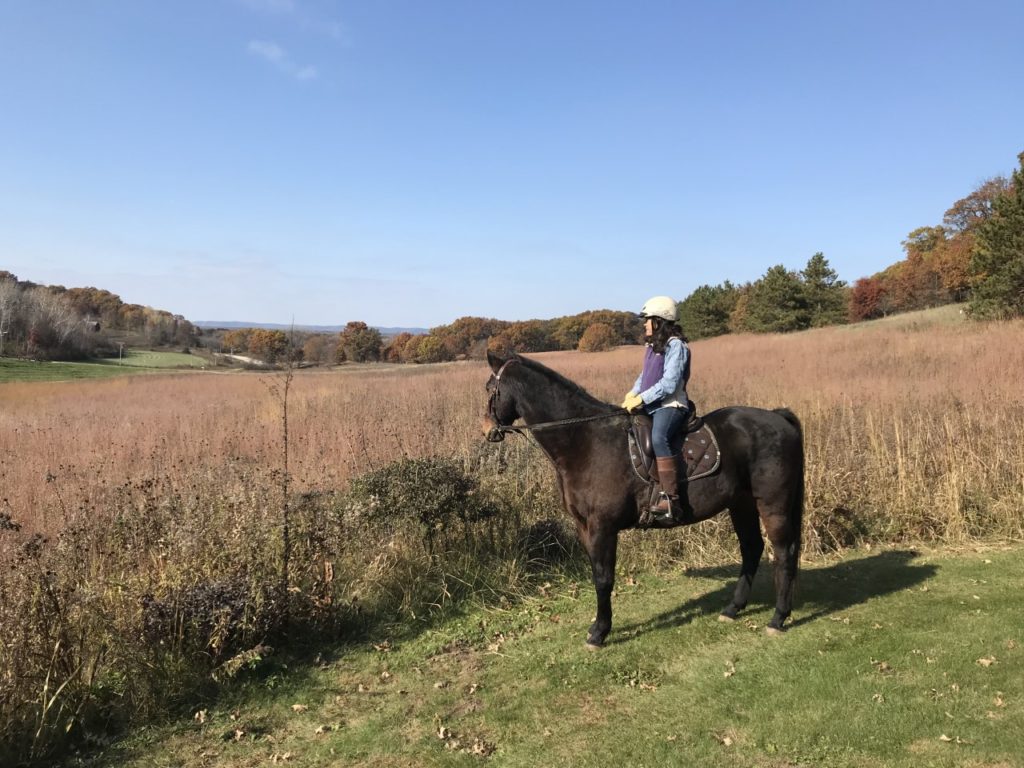
The Outstanding Vision of a Lady Landowner
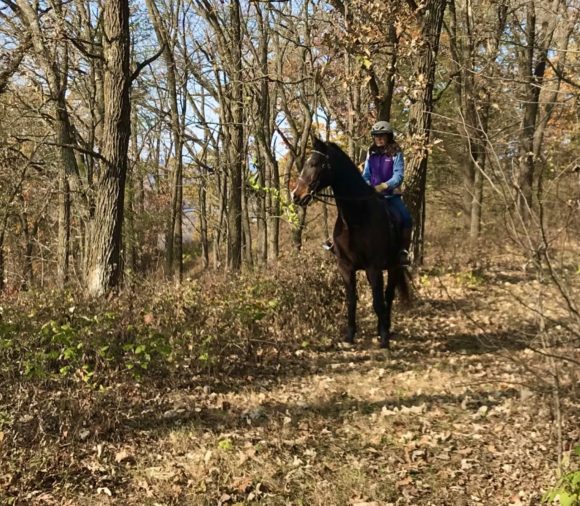
By Denise Thornton
The view from horseback connects Denise Marino to her land. “It was a dream to have land so I could have my horses near me,” she says. Denise and her husband, Herb Paaren ended their long search for a property they could love when they found 48 acres with a ridge top overlooking the Wisconsin River near Spring Green.
They first climbed their ridge in November 2001. “‘Leaf off’ is my favorite time out here,” says Denise. “It’s the whole visibility factor.” Whatever the season, her natural curiosity and librarian’s love of learning has made the land around her a perpetual master class. For Denise, “being a land owner is literally getting down on your knees and recognizing everything. It’s always changing, and I’ve noticed that the landscape has changed in nearby parks as well. Your viewpoint on land adjusts once you have land that you are connected to.”
Where ever she goes, Denise is always looking at the plants around her to learn how, and whether, they fit into the native environment. “When I go riding my horse or walking with my dog, I am always aware of what is around me,” she says. As soon as she gets back to her books, she searches to identify anything new. Her favorite resource is Wildflowers of Wisconsin and the Great Lakes Region: A comprehensive Field Guide by Merel R. Black and Emmet J. Judziewicz, 2nd Edition.
During her first year on her land, Denise trained with the Iowa County Chapter of the Wisconsin Master Gardener Program, which emphasizes extensive practical gardening skills. Master Gardener graduates are required to do volunteer gardening in their community, and, knowing she could assist with native and invasive work, they connected Denise with the Friends of Governor Dodge State Park, helping to restore prairie there. She has juggled various volunteer projects including The Gateway Prairie.
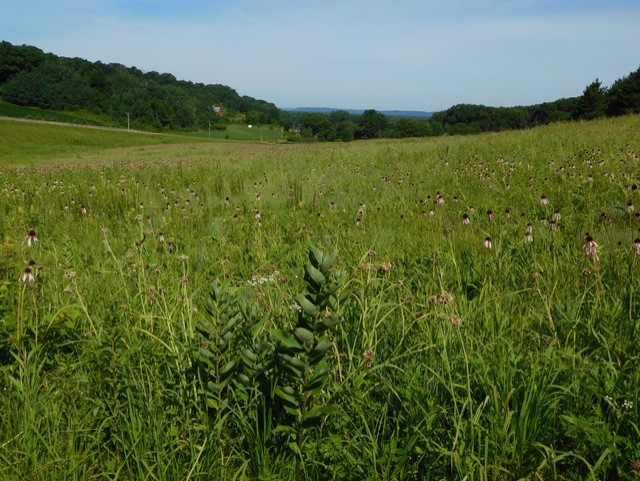
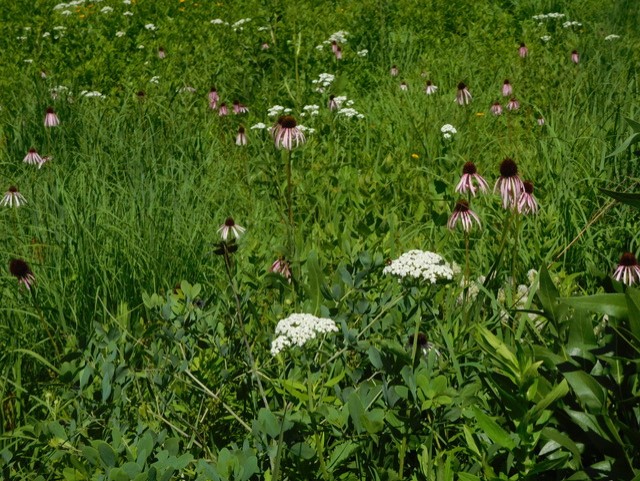
She also used her new-found gardening skills to surround the home she and Herb built in 2004 with flower beds. Denise soon learned that perennial beds, like those found in urban areas, require extra knowledge and effort to play well with the prairie and restored woodlands Herb was creating. Though she loves the idea of having conventional flower beds around the house, she knows that those beds could threaten the natural areas around them. “On 48 acres, it’s important to know if a flower can self sow. That’s how a lot of invasives got out there in the first place,” Denise notes. “I spend a lot of time deadheading the flowers in my beds up by the house so they don’t escape, and I’ve had to rip out some of my original choices because I couldn’t keep up with the deadheading.”
Long before building a home, they began to learn about and manage their property. “You get more of a connection when you are out there pulling and sweating,” says Denise. “That’s what curiosity does. You see something, learn about it and then get to work on it.” Their very first year, they began to burn their woods. “We were still living in Madison when Herb said, ‘We’re going to burn the woods.’ I’ve gone from freaking out about fire to can’t wait to burn! The burning we’ve done feels like house cleaning and purging. Underbrush and brambles on our north-facing hillside have been replaced with an incredible understory of ferns and bellwort.”
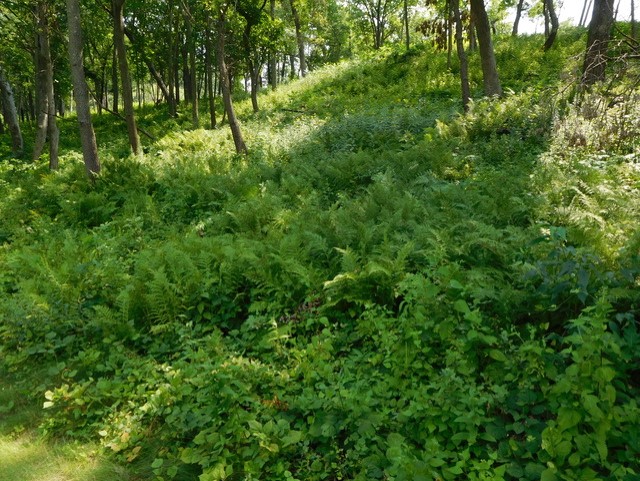
“It was fun having a neighbor on the same page,” she says. “We both got involved with the Aldo Leopold Foundation when we planted prairie.” Later Denise invited another friend who owns land to join her at a ‘women in land stewardship’ workshop organized by Alanna Koshollek, the ALF Evaluation Coordinator and other grant partners. “There were presenters there from different agencies, and I thought it might interest her,” Denise recalls.
Alanna, who was formally the stewardship coordinator at ALF, has had a lot of experience working with land owners. She observed that women in couples often shared much of their husbands’ vision for their land, “but women have their own ideas of their property – what they love about it, what they want to see in it, and what kind of questions they have,” says Alanna.
Land management professionals are seeing women outlive their mates, more women purchasing property on their own, and also men and women with hopes of inheriting properties owned by their parents. “We want to make sure we are reaching those women, and that they know who can help them to make important decisions on their properties,” says Alanna.
The Aldo Leopold Foundation, in partnership with staff from the Wisconsin Department of Natural Resources and UW-Extension at Madison, had a grant that involved using the learning circle technique to offer land management learning opportunities for women. “The circle used at women-only events is more warm and inviting than conventional lecture style,” says Alanna. “Women find it easier to share their own property stories along with their hopes and dreams peer-to-peer. We have had learning circles with natural resource professionals interspersed, and they share their experience and offer advice within the group. It creates a lot more room in the agenda to learn from one another. It allows land owners to drive the conversation and leave with information that will actually help them move forward.”
The circle grant has ended, but there are many opportunities for women to learn about their land. Another grant the foundation is collaborating on is starting up that will fuel specific landowner outreach to connect women with the information they need.
One way to jump into the learning circle approach is with the next few upcoming Wisconsin Women in Conservation led Learning Sessions on ZOOM. RSVPs are required at the above link.
Other resources worth exploring include:
The Wisconsin DNR,
My Wisconsin Woods,
UW-Extention,
Wisconsin Woodland Owners,
Women Owning Woodlands,
Women in Conservation,
Midwest Organic & Sustainable Education Service MOSES, and
Wisconsin Farmers Union
“Feeling the need to care for our land can be overwhelming, but what we want women to understand is that no matter how long you have owned land, or how involved you are in its management – it’s o.k. to start enjoying it and caring for it in whatever way that means to you,” says Alanna. “Don’t carry guilt for not doing more — if you have a young family, or you are at a busy point in your professional career, or any reason — just embrace and enjoy your property however you can, and that relationship will grow. You’ll develop a dialogue with the property and learn how it wants you to help care for it.”
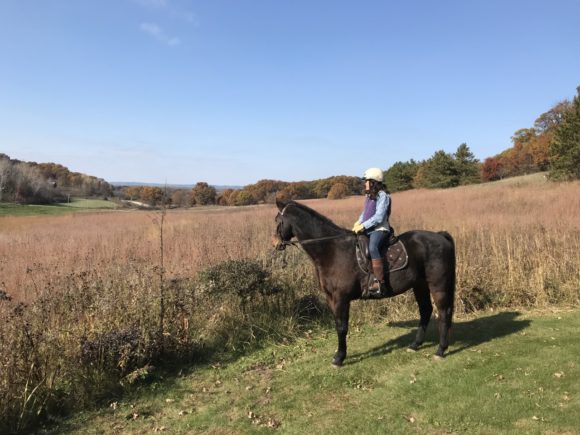
For Denise, asking questions and finding the answers has brought her very close to her land. “You never understand your property till you get down and personal,” she says. “You need that curiosity that leads you to understand plants and their relation to the environment. You need to connect with your hands. Watching the prairie plants moving around the property is great. This year we had an explosion of dotted mint. We’ve watched culvers’ root that jumping toward the woodlands. Now we are seeing more shooting stars. And our ferns – they were always there. They were just waiting to be released. Every time I am on foot or hoof I see how the land has given me joy and an understanding of the land ethic.”
